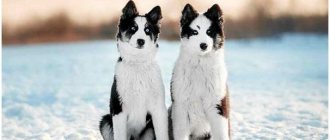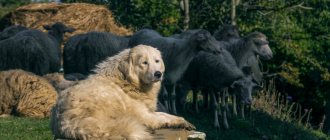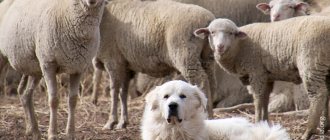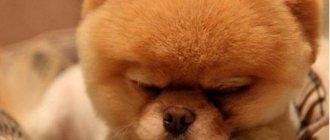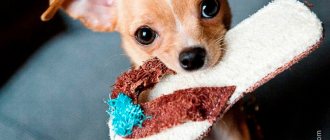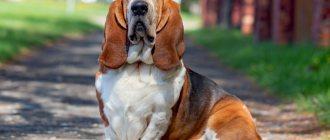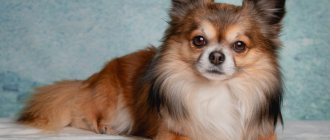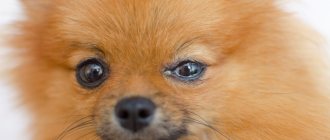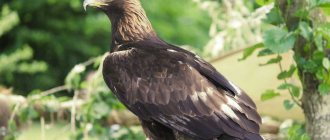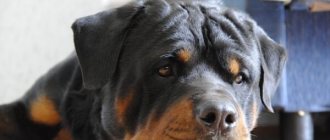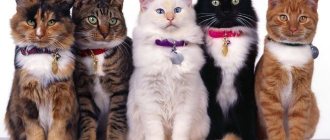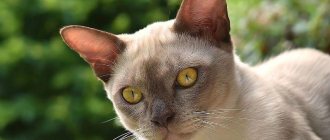History of the breed
How and when this breed appeared is currently quite difficult to say. However, experts claim that their ancestors were dogs domesticated by tribes of cattle breeders living in Tibet a couple of millennia BC. Subsequently, cattle breeders kept only the strongest of the tamed pets - this is how the breed of Tibetan dogs arose through natural selection. Subsequently, as a result of crossing these strong and powerful dogs with dog breeds that came to Tibet from outside, two new breeds were born: Asian Shepherds and Tibetan Great Danes (the ancestors of the group of modern Great Danes).
These dogs were taken with them on hikes and travels; as a result, Tibetan Great Danes appeared in other Asian countries, in particular in China, India, and Mesopotamia. These dogs developed the following qualities: strength, aggressiveness, and their powerful jaws could bite through the weapons of enemies (we are talking about the 1st-2nd millennium BC). Then these dogs came to Europe - first to Greece and the Roman Empire, and then to other countries.
By the tenth century AD, most of the descendants of the Tibetan Great Danes were in Germany. The Code of Forest Hunting Laws specifically described the descendants of these dogs (7 types of Great Danes). These domestic animals were used to hunt wild boars and bears, which already speaks of the strength of these dogs. After another 5 centuries, the direct ancestors of modern Great Danes appeared in Germany. Some experts believe that these individuals were obtained by crossing Molossians with English hunting breeds. As a result, this breed was called by different names:
- Great Danes;
- Great Danes;
- Old German Mastiffs;
- Bullenbeisers.
On the territory of Denmark and the German regions adjacent to it, the Great Dane was mainly bred, which was taken to breed purebred Great Danes, which exist today.
It was the Great Dane that became the standard of a fighting and guard dog, which was used in hunting to bait large wild animals. But later in Denmark the breeding of this breed practically ceased, so most of the Great Danes were concentrated in Germany, where by the middle of the nineteenth year, breeders began improving this breed by crossing Great Danes with other Great Danes. This subspecies is called the Ulm Great Dane. In northern Germany they also bred mastiff dogs.
Currently, there are several subspecies of the Great Dane breed, which, in addition to common features of appearance and character, also have some differences, which will be discussed in more detail in the descriptions of these varieties.
Description of the breed, characteristics
Among all large dogs, the Great Dane is one of the largest and most massive. And most likely, it was a representative of this breed that was described by Arthur Conan Doyle in his story “The Hound of the Baskervilles.”
The height of this pet at the withers can reach 0.8-0.9 m, but taller specimens are also found. The weight of an adult male can be up to 89-92 kg. The shape of the elongated muzzle depends on the subtype, the nose is quite wide, the nostrils are large. The shape of the eyes can be different, but most often it is almond. Tail length is slightly longer than average. Representatives of this breed are smooth-haired, which makes it easier for owners to care for their huge pets.
The body composition directly depends on the type of breed.
If the ancestors of these pets were distinguished by viciousness and aggressiveness, then modern Great Danes have practically lost these qualities - they have become calm and self-confident, they are distinguished by friendliness, sociability and devotion to their owner. However, with a lack of training and education, Great Danes can be stubborn and do not always control their behavior. It is simply impossible to do without long sessions with dog handlers when training puppies of this breed.
The Great Dane is a dog that will have to be spent a lot of time training and taking him for walks. You shouldn’t have such a huge pet in a small apartment, because it needs a lot of free space.
Price of a dog
The most important question that worries those who dream of owning a Great Dane is the price. It is worth considering that the breed is not cheap. However, on message boards on the Internet, breeders write completely different prices with a fairly large threshold. How much does a Great Dane cost, and what does the price depend on?
- Breeding dogs can be found for around $300 . Puppies at this price will not be purebred.
- The average cost of a purebred Great Dane is about $700.
- If you want a dog of a rare color, born from titled parents, then you will have to pay at least $1,000 .
To read: Chow-chow breed characteristics, education and care of the dog
The Great Dane is a breed for wealthy and experienced breeders. A dog requires care, competent training and fairly large investments. Still, it's worth it.
Breed standard
The main standard of the Great Dane breed implies the following characteristics of dogs:
- elongated body shape, proportionally folded;
- elongated muzzle with powerful jaws, high-set triangular ears;
- correctly placed strong limbs;
- tail – medium size and thickness;
- the coat is smooth, colors can be different - from marble to black;
- eyes are almond-shaped.
But different subtypes of this breed may have different standards.
Advantages and disadvantages
The main advantages of this breed include:
- high intelligence;
- perfectly developed memory;
- smooth short coat that is easy to care for;
- can be a good guard or watchman.
These pets have practically no disadvantages. It may be noted that some individuals may have problems with the gastrointestinal tract - for example, volvulus. Also, these dogs have a short lifespan - about 8 years.
Health
On average, a Great Dane can live 6.5-7 years. We can say that nature has blessed these dogs with good health, but a predisposition to certain diseases is still observed:
- Problems with the gastrointestinal tract - bloating, volvulus, diarrhea.
- Hip dysplasia – accompanied by pain, lameness and immobility.
- Dermatitis is an inflammation of the skin.
- Lymphoma is a type of malignant cancer.
- Pyoderma - accompanied by an accumulation of pus. In the superficial form, the outer layers and hair follicles are affected. The deep form of pyoderma is accompanied by damage to the skin throughout its entire thickness.
- Cervical spine instability.
- Demodicosis is a parasitic disease. Caused by microscopic mites of the genus Demodex, which feed on skin and loose fiber.
- Congenital idiopathic megaesophagus is a disorder of contractility and dilatation of the esophagus.
- Osteochondrosis of the shoulder is a serious disease that affects the joints. Characterized by cartilage degeneration. It manifests itself as ossification of the cartilage with further destruction of the joint.
- Entropion, eversion of the eyelids - is eliminated surgically.
- Obesity.
It is easier to prevent a disease than to treat it later. Therefore, it is important to regularly undergo preventive examinations with your pet at a veterinary clinic. Timely vaccination and treatment against skin parasites are also mandatory.
Varieties
There are several varieties of Great Danes, which differ quite greatly in appearance, so the main subtypes should be described in more detail.
German
Representatives of this subtype are among the largest dogs in the world. These pets can reach a height at the withers of up to 92 cm (males), and females - up to 83 cm. These natives from Germany weigh up to 89 kg - boys, girls are a little lighter - about 60 kg.
When this breed was bred, its purpose was to bait large wild animals (bears, wild boars). Currently, they are used as excellent companions, guard dogs or watchdogs.
The standard for this subtype is as follows:
- head – elongated, narrow, proportional to the length of the body;
- neck – larger than average size with well-developed muscles;
- rectangular muzzle with a wide nose and oval eyes;
- high-set ears of medium length;
- The body shape is square, in girls it can be elongated. The short back smoothly transitions into a slightly curved lower back, the wide chest descends almost to the knee joints. The abdomen is usually tucked in;
- the front and hind legs are strong, correctly placed, the paws are dense, rounded;
- smooth, dense wool can have the following colors: black, blue, brindle, fawn, merle.
Bordeaux
Dogues de Bordeaux were bred by French breeders. These huge dogs can reach a height of 68 cm at the withers, and their weight can range from 52 to 90 kg.
The skin of these dogs is wrinkled, forming many folds on the face and body. Body – with well-developed muscles and a wide chest. The large head with a wide frontal part and a blunt muzzle is attached to the body by a small neck. Legs are short and strong.
These dogs are smooth-haired, the color can only be red (of different shades). According to the standard, there may be a darker mask on the face, and one large white spot on the chest.
Argentinian
This dog is built like an athlete, like a Great Dane, and can be a watchman, hunter or guard. The height of males does not exceed 66-67 cm, females - up to 64 cm. Their weight does not exceed 43-44 kg.
But the appearance of the Dogo Argentino is quite intimidating due to the powerful jaws and general expression of the muzzle.
His body is strong, with well-developed muscles, his back is wide, his lumbar region is powerful and his chest is voluminous. The head is shorter than that of Great Danes, with wide nostrils, thick lips, ears set high, and almond-shaped eyes. Argentines are smooth-haired, with snow-white soft fur. The neck is powerful, with good muscles. The straight, powerful limbs end in rounded paws.
Great Dane
The generally accepted name of the breed is the English Mastiff. Considered the largest dog in the world (in terms of height and weight). These are one of the very first Molossian dogs to appear in Europe. They were used as gladiators in the arena, as fighters in dog fights, as working and guard dogs . Later, the British decided to teach mastiffs to hunt. The dogs became baiting dogs and attacked the bears in groups.
Interestingly, mastiffs were also used in jewelry. The pet was fed a precious stone with a piece of meat and crushed bones. In the stomach, the diamond was polished and came out polished and shiny.
The height of Great Danes is at least 78 cm, weight is at least 75 kg . There is no upper limit for the breed. The animals are very large and heavy with an angular head and a strong, elongated body, surrounded by thick folds of skin.
Like all Molossians, the English have a wrinkled muzzle and long ears. The coat is short, the color is beige, yellow, wheat, apricot, fawn, tan, brindle. A black mask is required.
This is a very calm, balanced dog without a drop of aggressiveness. Great Danes make excellent nannies for children: they are kind, loving, playful, and know how to handle their strength. The dog will not even attack an intruder, it will simply not allow him to enter the house. The main weapon of the breed is its intimidating appearance.
Animals have developed intelligence, so they are easy to train. The owner for the Mastiff is authority. Despite their external phlegmatic and lazy appearance, Dogs love to play and train. The average cost of a puppy is 40,000 rubles.
Maintenance, care
The maintenance of these large pets begins with preparing a place for it, which is not recommended to be changed in the future. Since the Great Dane puppy will grow into a huge dog in the future, he needs a lot of space in the apartment, as well as a lot of free time from the owner for joint activities with the pet. Therefore, if the apartment is small, or all family members are too busy, then it is better not to purchase a Dog.
It is also not recommended to get this particular dog if the novice dog breeder has not previously had experience raising these particular pets. After all, raising and training these huge and sometimes very stubborn dogs requires from the dog breeder not only time, but also skill, as well as strength, patience and a certain character, so that the dog can feel who is in charge in the house.
These pets (due to their large size) require long daily walks. And if the puppy should not be forced against his will to take long walks, then older pets themselves are willing to go for walks with the owner. Moreover, when walking different subtypes of Dogs, it is better to alternate between just walking and jogging. The best place for walking is on hard ground, where the dog can run calmly without knocking its paws.
Great Dane subspecies with long legs can often have joint problems, so you should be careful about the appearance of even mild lameness. Also, such dogs are prone to colds, so there should be no drafts in the place where your pet will rest, and you should also provide him with soft bedding.
You need to bathe your Great Dane when it gets dirty, and you need to brush it daily. It is better to use a special massage brush for this.
Feeding
It is better to feed such dogs homemade food. But it should be remembered that in the spring and summer the diet should contain less food rich in proteins and carbohydrates, but in the fall and winter the amount of such food is increased. As the puppies grow, the amount of food increases in proportion to the dogs' growth.
The puppy at home continues to be fed the same food that he received from the breeder, but gradually you can accustom him to an adult diet. Such large breeds need meat in sufficient quantities, but it is better not to feed chicken.
Upbringing
It is better to start raising such proud and slightly stubborn pets from the first day the puppy appears in the house. The main thing is that the puppy gets used to the owner and trusts him completely.
Important! These dogs are highly intelligent and quickly remember commands. Training puppies should begin with walking on a leash - these dogs do not like this procedure, so they should be taught without shouting, rewarding them for the slightest achievement.
Gradual training of a puppy in the rules of behavior in the house and on walks can begin from childhood, but serious training begins no earlier than the dog is six months old. It is better to take the Dog to an experienced instructor at the first stage of training - he will teach the dog basic commands and tell the owner how to practice them correctly at home or on a walk.
Parenting mistakes
Obvious mistakes in education include:
- irregular exercises with the dog;
- intemperance of the owner, practicing commands in a raised voice, frequent assault when the pet disobeys;
- training this large pet in crowded places, if the dog is not yet sufficiently trained.
Nutrition
There are only 2 options for feeding a representative of the breed - professional and natural. The first involves feeding on dry food, and the second on human food. Each of them has both advantages and disadvantages.
If you chose the first option, then we strongly advise against buying cheap food without minerals for your dog. Its use by a dog can provoke the appearance of pathological processes in its body. Therefore, choose only a high-quality commercial product for her!
Regarding natural feeding. Your Great Dane puppy should receive carbohydrates, fiber, and protein on a regular basis. All these substances are found in cottage cheese, milk, raw meat and vegetables. We recommend feeding him at least 5 times a day.
Since an adult representative of the breed is very large, it requires quite a lot of food. Every day he must eat at least one and a half kilograms of food. You should also regularly pour clean water into his bowl (an energetic dog drinks a lot).
Puppies
Before purchasing a Great Dane puppy, you should be aware that this is a dog that will grow very large and will require special care (in particular, you will need to walk it for a long time and train it regularly). If the future dog breeder does not have such an opportunity, it is better to choose puppies of simpler breeds for purchase.
Choosing a puppy
Young animals should be purchased at least 3 months old. Puppies at this age have already formed a strong skeleton, well-developed muscles, and the future pet itself is quite well-fed and active. Limbs – correctly placed, long enough.
Price
The price for such dogs ranges from 20 to 50 thousand rubles. This price range depends on whether the puppy has a pedigree, vaccination data and other necessary information. And the price for puppies from elite champion parents will be the highest. And, as a rule, sellers offer to use such puppies in the future for participation in exhibitions and further breeding.
Norwich Terrier
A small English hunter whose ancestor is the Norfolk Terrier. The dogs are compact, with a short back, pointed ears and coarse short hair with a characteristic “collar” around the neck. This is a good-natured, extremely active and quickly reacting to all events, a dog that does not show aggression towards people and pets.
It treats the beast in the hole decisively and fearlessly; when using the Norwich as a working dog, you can notice scars from fierce fights. These marks are not grounds for abandoning the pet's show career. You can buy a Norwich baby for an amount exceeding 50,000 rubles.
Owner reviews
According to reviews from owners, Great Danes are dogs that will be devoted pets who love their owner and his family members. Proud and calm representatives of this breed, with proper training, will be calm in any situation, obeying only the orders of their owner.
Although representatives of this breed seem stern and angry, according to those who keep dogs of this breed, in fact, there is practically no manifestation of aggression in Great Danes, they get along well with other pets, love children and will never attack other dogs. walk.
Dogo Brasil
The Fila Brasileiro or Dogo Brasileiro is a large working dog native to South America. There is no exact history of the origin of the breed, but there is a theory that the Portuguese brought Great Danes to Brazil, which they bred with the native Fila dogs. Later Bloodhound and Bulldog blood was added.
The resulting dog was distinguished by incredible strength and endurance . In addition, he was known as a good hunter. That’s why dogs were used in all spheres of human life: in the mines Dogi pulled carts, in pastures they guarded livestock, in the city they pulled carts with meat, in the forest they attacked large prey.
The breed was also a guard dog and worked for a long time in the military and police services. The main task of the dogs was to find and knock down runaway slaves.
This is a typical Molosser with all the external features: strong, powerful bones, an elongated body, a folded muzzle, long ears, sagging thick skin, a sleepy look. Dogs grow up to 75 cm and weigh up to 50 kg.
Fila are very athletic and hardy; they can work for a long time in the heat, but are completely unsuited to the cold. Their thin wool cannot cope with heating the body in cold weather. Standard colors are fawn and brindle, although any colors are acceptable.
The Dogo Brasil is a versatile breed, but now the dogs are kept as guards. It is interesting that, despite their size and strength, Phils have never participated in dog fights; they get along well with other pets, but they do not like strangers, especially those who have their backs turned to them or run away.
Fila Brasileiro is a devoted dog who dotes on his owner and cannot stand loneliness, so he is not suitable for chain keeping. The dog needs a spacious country house with a yard, not a city apartment.
In order for a pet to obey, it must be trained from early childhood. Lack of training will lead to uncontrollable behavior. The average cost of Phil's puppies is 30,000-50,000 rubles .
